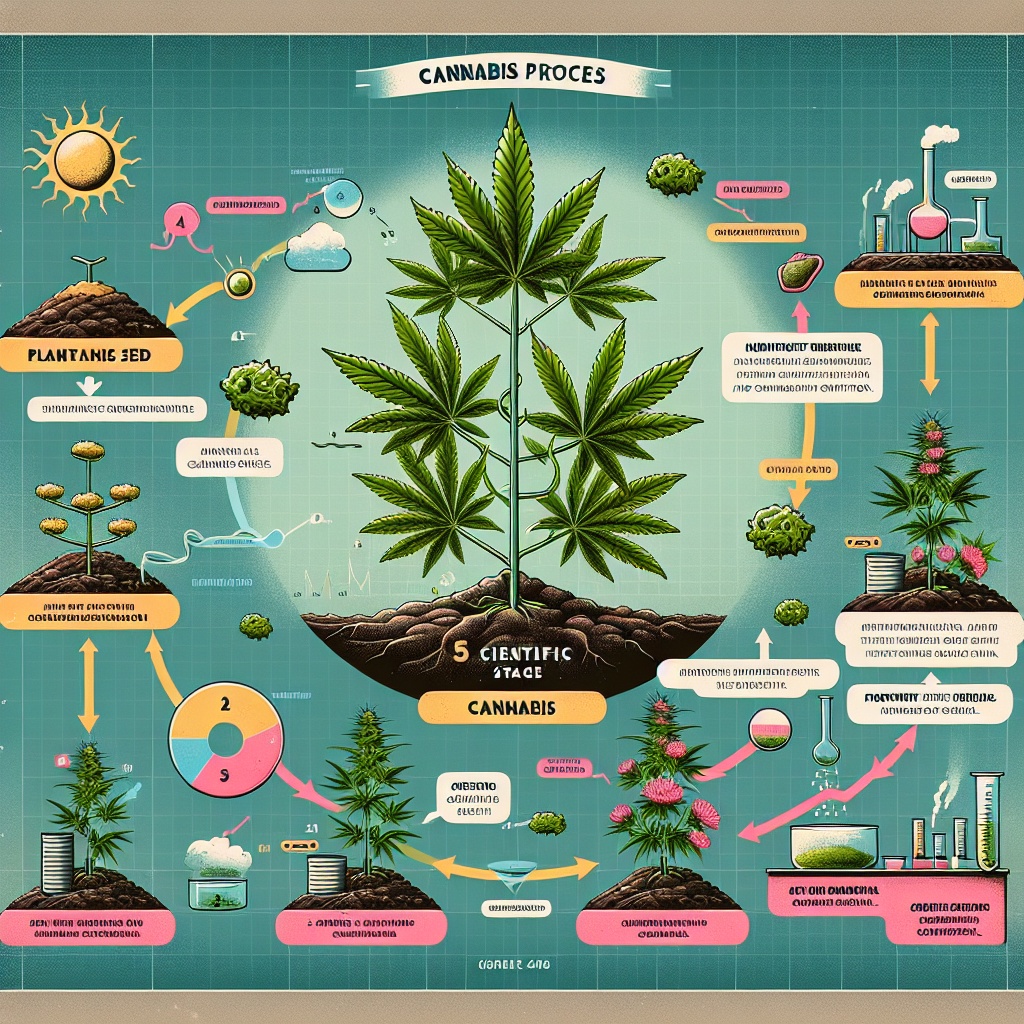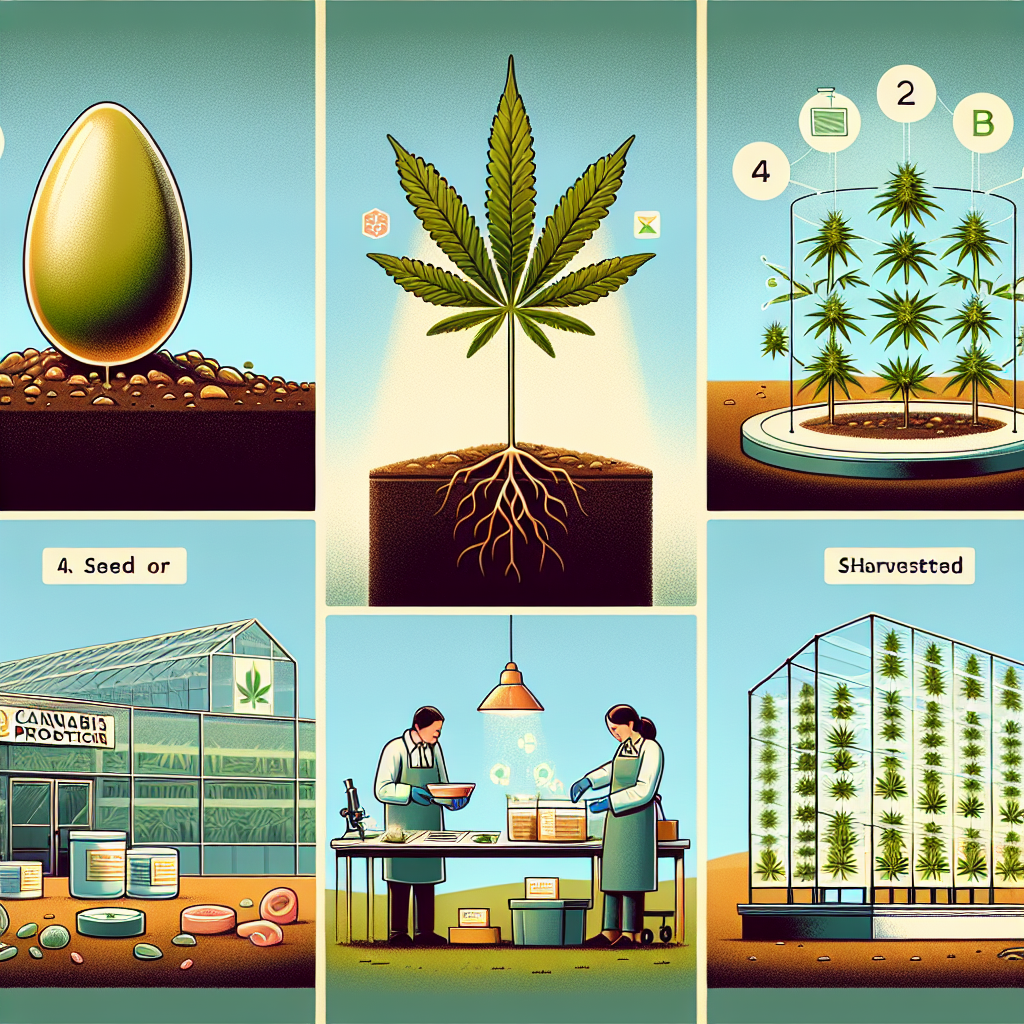The Science Behind Cannabis Production: From Seed to Sale
Cannabis production is a complex and multifaceted process that integrates various scientific disciplines, from botany and genetics to chemistry and pharmacology. The journey from seed to sale involves several critical stages, each requiring precise control and understanding to ensure the quality and efficacy of the final product. Starting with the selection of high-quality seeds, the cultivation process demands careful attention to soil composition, light cycles, and nutrient management to optimize plant growth. Advanced breeding techniques and genetic engineering are employed to enhance desirable traits such as potency, yield, and disease resistance. Once harvested, the cannabis undergoes rigorous processing, including drying, curing, and extraction, to produce a range of products from raw flower to concentrates and edibles. Quality control measures, including lab testing for cannabinoid content and contaminants, are essential to meet regulatory standards and ensure consumer safety. The science behind cannabis production is continually evolving, driven by ongoing research and technological advancements, making it a dynamic and rapidly growing field.
Understanding Cannabis Genetics: The Role of Seed Selection
Understanding cannabis genetics is crucial for anyone involved in the cultivation and production of this versatile plant. The journey from seed to sale begins with the careful selection of seeds, a process that significantly influences the quality, potency, and characteristics of the final product. To appreciate the importance of seed selection, it is essential to delve into the science behind cannabis genetics and how it shapes the plant’s development.
Cannabis, like all plants, inherits its traits from its parent plants through genetic material. These traits include everything from the plant’s height and yield to its cannabinoid profile and resistance to pests. When selecting seeds, growers must consider these genetic factors to ensure they cultivate plants that meet their specific needs and goals. For instance, a grower aiming to produce high-CBD strains for medicinal purposes will prioritize seeds with a genetic predisposition for elevated CBD levels.
The process of seed selection begins with understanding the difference between various types of cannabis seeds: regular, feminized, and autoflowering. Regular seeds can produce either male or female plants, which is a critical consideration since only female plants produce the buds rich in cannabinoids. Feminized seeds, on the other hand, are bred to produce exclusively female plants, thereby eliminating the need to identify and remove male plants. Autoflowering seeds are genetically designed to transition from the vegetative stage to the flowering stage automatically, regardless of light cycles, making them an attractive option for growers seeking a quicker and more straightforward cultivation process.
Once the type of seed is chosen, the next step is to consider the strain. Cannabis strains are typically categorized into three main types: Indica, Sativa, and hybrid. Indica strains are known for their relaxing effects and shorter, bushier growth patterns, making them suitable for indoor cultivation. Sativa strains, in contrast, are associated with uplifting effects and taller, more slender growth, often requiring more space and light. Hybrids combine characteristics of both Indica and Sativa, offering a balance that can be tailored to specific cultivation environments and consumer preferences.
Beyond the basic categorization, each strain has a unique genetic profile that determines its cannabinoid and terpene content. Cannabinoids like THC and CBD are the primary compounds responsible for the plant’s psychoactive and therapeutic effects. Terpenes, on the other hand, are aromatic compounds that contribute to the plant’s flavor and aroma while also influencing its effects. By selecting seeds with the desired cannabinoid and terpene profiles, growers can produce cannabis that meets the specific demands of their target market.
Moreover, the genetic stability of the seeds is another critical factor. Stable genetics ensure that the plants will consistently exhibit the desired traits, which is particularly important for commercial growers who need to maintain product quality and uniformity. This stability is achieved through careful breeding practices that involve selecting parent plants with strong, desirable traits and crossbreeding them over multiple generations.
In conclusion, understanding cannabis genetics and the role of seed selection is fundamental to successful cannabis production. By carefully choosing the right type of seeds and strains, considering their genetic profiles, and ensuring genetic stability, growers can cultivate high-quality cannabis that meets their specific needs and the expectations of their consumers. This scientific approach to seed selection not only enhances the efficiency and effectiveness of the cultivation process but also contributes to the overall advancement of the cannabis industry.
The Growth Cycle: From Germination to Harvest

The journey of cannabis from a tiny seed to a fully mature plant ready for harvest is a fascinating process that involves several distinct stages, each crucial for the plant’s development. Understanding the growth cycle of cannabis not only provides insight into the plant’s biology but also highlights the meticulous care required to produce high-quality cannabis. The cycle begins with germination, a stage where the seed awakens from its dormancy. During this phase, the seed absorbs water, swells, and eventually cracks open, allowing the embryonic root, known as the radicle, to emerge. This root anchors the plant and begins to absorb nutrients from the soil, setting the stage for the next phase: seedling development.
As the seedling emerges, it starts to develop its first set of leaves, known as cotyledons. These initial leaves are crucial as they begin the process of photosynthesis, converting light into the energy needed for growth. During this stage, the plant is particularly vulnerable and requires optimal conditions, including adequate light, water, and nutrients. The seedling phase is relatively short, lasting only a few weeks, but it sets the foundation for the plant’s future growth.
Transitioning from the seedling stage, the cannabis plant enters the vegetative phase. This is a period of rapid growth where the plant focuses on developing a strong structure, including stems, branches, and a robust root system. During the vegetative stage, the plant requires increased amounts of light, typically around 18 hours per day, to fuel its growth. Nutrient needs also change, with a higher demand for nitrogen to support the development of lush, green foliage. This phase can last anywhere from a few weeks to several months, depending on the desired size of the plant and the specific growing conditions.
Following the vegetative stage, the cannabis plant transitions into the flowering phase, which is triggered by a change in the light cycle, usually to 12 hours of light and 12 hours of darkness. This shift signals the plant to start producing flowers, which are the most sought-after part of the cannabis plant. During the flowering stage, the plant’s energy is redirected from vegetative growth to the development of buds. This phase is critical as it determines the quality and potency of the final product. The plant’s nutrient requirements also shift, with a greater need for phosphorus and potassium to support bud development.
As the flowering phase progresses, growers must carefully monitor the plants to determine the optimal time for harvest. This involves observing the trichomes, the tiny resin glands on the flowers, which change color as the plant matures. When the trichomes reach the desired level of maturity, usually indicated by a milky white or amber color, it signals that the plant is ready for harvest. Harvesting at the right time is crucial to ensure the best possible flavor, potency, and overall quality of the cannabis.
Once harvested, the cannabis undergoes a drying and curing process to preserve its qualities and enhance its flavor. This involves hanging the plants in a controlled environment to slowly reduce moisture content, followed by curing in airtight containers to further develop the aroma and potency. The entire growth cycle, from germination to harvest, is a complex and delicate process that requires careful attention to detail and a deep understanding of the plant’s needs. By mastering each stage of the growth cycle, cultivators can produce high-quality cannabis that meets the demands of consumers and stands out in a competitive market.
Extraction Methods: Turning Raw Cannabis into Marketable Products
The journey from raw cannabis to marketable products involves a fascinating array of extraction methods, each designed to harness the plant’s valuable compounds. Understanding these methods not only sheds light on the science behind cannabis production but also helps consumers make informed choices about the products they use. The extraction process begins with the selection of high-quality cannabis plants, which are cultivated with care to ensure they contain the desired levels of cannabinoids and terpenes. Once harvested, the raw plant material undergoes a series of steps to isolate these compounds, transforming them into various forms such as oils, tinctures, edibles, and topicals.
One of the most common extraction methods is solvent-based extraction, which uses substances like ethanol, butane, or CO2 to dissolve the cannabinoids and terpenes from the plant material. Ethanol extraction, for instance, involves soaking the cannabis in ethanol, which acts as a solvent to pull out the desired compounds. The mixture is then filtered and the ethanol is evaporated, leaving behind a concentrated extract. This method is praised for its efficiency and ability to produce a full-spectrum extract, meaning it retains a wide range of cannabinoids and terpenes, offering a more holistic effect.
Similarly, butane extraction, also known as Butane Hash Oil (BHO) extraction, uses butane as the solvent. The process involves passing butane through the cannabis material, which dissolves the cannabinoids and terpenes. The resulting solution is then purged of butane, typically through a vacuum oven, to ensure the final product is safe for consumption. BHO extraction is known for producing highly potent concentrates, such as shatter, wax, and budder, which are popular among consumers seeking strong effects.
On the other hand, CO2 extraction is considered one of the safest and most environmentally friendly methods. This technique utilizes supercritical CO2, which acts as both a gas and a liquid under high pressure and low temperature. The supercritical CO2 is passed through the cannabis material, extracting the cannabinoids and terpenes without leaving behind any harmful residues. The CO2 is then separated from the extract and can be reused, making this method both efficient and sustainable. CO2 extraction is highly regarded for its ability to produce clean, high-quality extracts that are free from solvents.
In addition to solvent-based methods, there are also solventless extraction techniques, which rely on physical means to separate the desired compounds. One such method is rosin pressing, where heat and pressure are applied to the cannabis material to squeeze out the resinous sap containing the cannabinoids and terpenes. This method is favored for its simplicity and the fact that it does not involve any chemicals, resulting in a pure and natural product.
Another solventless technique is ice water extraction, also known as bubble hash. This process involves agitating the cannabis material in ice-cold water, causing the trichomes (the resin glands containing cannabinoids and terpenes) to break off and sink to the bottom. The trichomes are then collected, dried, and pressed into hash. This method is appreciated for its ability to produce a potent and flavorful concentrate without the use of solvents.
Each extraction method has its own advantages and is chosen based on the desired end product and the specific needs of the producer. Whether through solvent-based or solventless techniques, the goal remains the same: to efficiently and safely transform raw cannabis into marketable products that meet the diverse preferences of consumers. As the cannabis industry continues to evolve, advancements in extraction technology will undoubtedly lead to even more innovative and refined products, further enhancing the consumer experience.
Quality Control: Ensuring Consistency and Safety in Cannabis Products
Quality control is a critical aspect of cannabis production, ensuring that every product reaching the consumer is both safe and consistent. From the moment a cannabis seed is planted to the time the final product is sold, rigorous quality control measures are in place to maintain high standards. This process begins with the selection of seeds, where only those with the best genetic profiles are chosen to ensure robust growth and high yield. As the plants grow, they are monitored closely for any signs of disease or pest infestation, which could compromise the quality of the final product.
Transitioning from cultivation to harvesting, the timing of the harvest is crucial. Harvesting too early or too late can affect the potency and flavor of the cannabis. Once harvested, the plants undergo a drying and curing process, which is essential for developing the desired aroma and taste. During this phase, the environment is carefully controlled to prevent mold and mildew, which can be harmful to consumers.
Moving forward, the dried cannabis is then processed into various products, such as oils, edibles, and topicals. Each of these products requires specific quality control measures. For instance, when producing cannabis oil, the extraction process must be meticulously managed to ensure that no harmful solvents remain in the final product. Similarly, edibles must be produced in a way that ensures even distribution of cannabinoids, so that each serving contains a consistent dose.
Throughout the production process, laboratory testing plays a vital role in quality control. Samples from each batch are tested for cannabinoid content, terpene profile, and the presence of contaminants such as pesticides, heavy metals, and microbial impurities. These tests are conducted by independent, third-party laboratories to ensure unbiased results. The data from these tests not only confirm the safety of the product but also provide valuable information about its potency and effects, which is crucial for both medical and recreational users.
In addition to laboratory testing, good manufacturing practices (GMP) are implemented to maintain consistency and safety. GMP guidelines cover every aspect of production, from the cleanliness of the facilities to the training of staff. By adhering to these guidelines, producers can minimize the risk of contamination and ensure that each product meets the same high standards.
Packaging and labeling are also important components of quality control. Proper packaging protects the product from light, air, and moisture, which can degrade its quality over time. Labels must provide clear and accurate information about the product, including its cannabinoid content, recommended dosage, and any potential allergens. This transparency helps consumers make informed decisions and use the product safely.
Finally, quality control extends to the point of sale. Retailers must store cannabis products in conditions that preserve their quality and prevent unauthorized access. They also play a role in educating consumers about the proper use and storage of cannabis products, further ensuring their safety and effectiveness.
In conclusion, quality control in cannabis production is a comprehensive process that spans from seed to sale. By implementing stringent measures at every stage, producers can ensure that their products are safe, consistent, and of the highest quality. This not only protects consumers but also builds trust in the burgeoning cannabis industry, paving the way for its continued growth and acceptance.
Q&A
1. **What are the primary stages of cannabis cultivation?**
– The primary stages of cannabis cultivation are germination, seedling, vegetative growth, flowering, and harvesting.
2. **How does light affect cannabis growth?**
– Light affects cannabis growth by influencing photosynthesis, which is crucial for plant development. Different light spectrums are used during the vegetative (blue light) and flowering (red light) stages to optimize growth and yield.
3. **What role do nutrients play in cannabis cultivation?**
– Nutrients are essential for cannabis cultivation as they provide the necessary elements for plant growth, including nitrogen, phosphorus, and potassium, which support various physiological functions such as root development, flowering, and overall plant health.
4. **How is cannabis potency tested before sale?**
– Cannabis potency is tested before sale using methods like High-Performance Liquid Chromatography (HPLC) to measure the concentration of cannabinoids, such as THC and CBD, ensuring product quality and consistency.
Conclusion
The science behind cannabis production encompasses a comprehensive and intricate process from seed to sale, involving multiple stages such as genetic selection, cultivation, harvesting, processing, and distribution. Genetic selection focuses on breeding strains with desirable traits, while cultivation requires precise control of environmental factors like light, temperature, and nutrients to optimize plant growth. Harvesting at the right time ensures maximum potency and quality, followed by processing methods like drying, curing, and extraction to prepare the product for consumption. Finally, rigorous testing for potency, contaminants, and compliance with regulations ensures the safety and efficacy of the final product before it reaches consumers. This multifaceted approach integrates agricultural science, chemistry, and regulatory standards to produce high-quality cannabis products.


